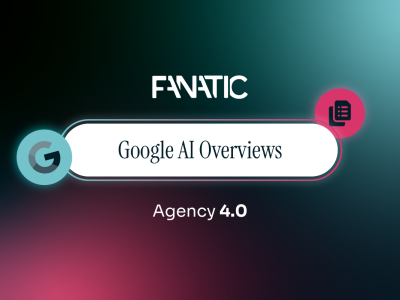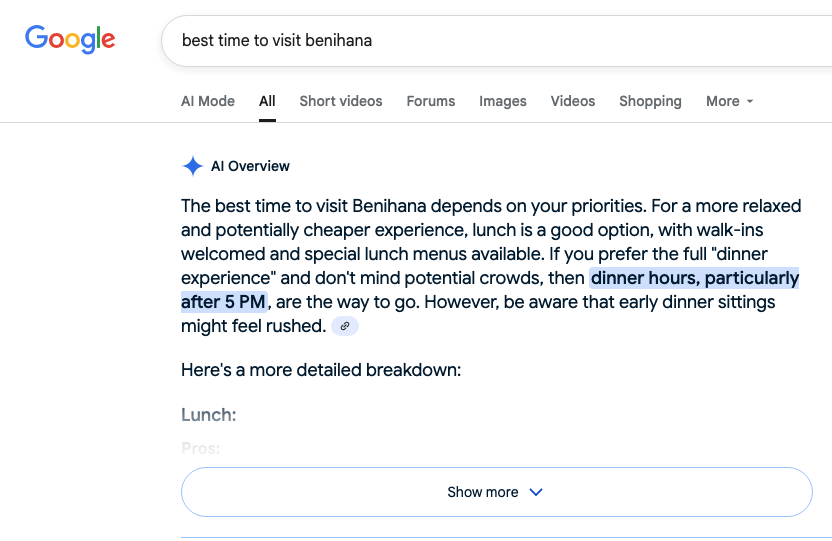August 13, 2025
Best practices for measuring the impact of Google AI Overviews on your website.

As Google’s AI Overviews reshape the search landscape in 2025, website owners face a critical challenge: traditional metrics no longer tell the complete story. With AI Overviews triggering for 13.14% of searches by March 2025¹, understanding how to measure your website’s performance in this new ecosystem has become essential for maintaining competitive advantage.
The fundamental issue with tracking AI Overview performance lies in Google Search Console’s limitations. Performance data for URLs featured in AI Overviews is included in GSC, though there is no way to separate or filter this data specifically for AI Overviews². In a recent interview with Aleyda Solis, Google’s Search Liaison Danny Sullivan confirmed there are no plans to provide AI Overview-specific data in Search Console, citing “technical debt” and the experimental nature of AI Overviews as reasons for this decision³. When your content appears in an AI Overview, impressions and clicks are recorded but merged with regular organic search data, making isolation impossible. All URLs within the AI Overview typically inherit position one in GSC², further complicating performance analysis.
Since Google doesn’t provide dedicated AI Overview metrics, third-party SEO tools have become indispensable. Tools like Semrush, Ahrefs, and Authoritas offer insights that can complement GSC data. These tools can identify which queries trigger AI Overviews and the URLs that rank within them². By blending this data with GSC metrics, you can begin to piece together a clearer picture of how AI Overviews influence visibility, clicks, and overall performance.
Best practice involves creating a systematic approach to data integration. Start by exporting your AI Overview visibility data from your SEO tool of choice, focusing on keywords where your content appears in AI Overviews. Create a master spreadsheet that includes columns for keyword, search volume, AI Overview presence (yes/no), your URL featured, and the date range. We suggest exporting data weekly because AI Overviews change often.
Next, pull impressions, clicks, CTR, and average position values from Google Search Console for the exact keywords and date range. Match this GSC data with your SEO tool exports using the keyword as your primary key. This alignment allows you to identify patterns between AI Overview appearances and performance metrics.
To calculate the impact of AI Overviews, track the before-and-after percentage changes in clicks, impressions, and CTR for keywords that gained or lost AI Overview visibility during your measurement period. Consider creating separate tracking for informational versus commercial queries, as AI Overviews affect these differently.
For ongoing monitoring, automate this process where possible using tools like Google Sheets with API connections or business intelligence platforms. Set up weekly or monthly data pulls to track trends over time, identifying which content types consistently earn AI Overview placement and their corresponding performance impacts.

The era of chasing click volume is ending. When people click to a website from a link on an AI Overview, these clicks are higher quality, as these users are more likely to spend more time on the site⁴. This shift requires recalibrating success metrics to prioritise engagement depth and conversion rate, among others, over raw traffic numbers.
Consider looking at various indicators of conversion on your site, be it sales, signups, a more engaged audience, or information searches about your business⁴. Track these metrics separately for traffic potentially influenced by AI Overviews to understand the actual value of this visibility.
Start by segmenting your analytics data to identify visitors who likely came through AI Overviews. Look for patterns in user behaviour that indicate higher intent: pages per session exceeding your site average by 20% or more, session duration that’s notably longer than typical visits, and bounce rates significantly lower than your baseline, for example. These users often arrive with more context about your content, having already seen a summary in the AI Overview, making them more likely to engage deeply with your material.
Configure custom events in Google Analytics 4 to capture meaningful interactions beyond page views. Track scroll depth to understand if users are consuming entire articles, monitor video engagement rates for embedded content, and measure form completion rates for lead generation. Create custom conversion events for actions that indicate genuine interest: downloading resources, clicking through to product pages, engaging with interactive tools, or spending time with your key content pieces.
You can also establish quality score frameworks that combine multiple engagement signals. For example, create a weighted scoring system where time on page accounts for 25%, pages per session for 25%, conversion actions for 30%, and return visits within 30 days for 20%. This composite metric provides a more nuanced view of visitor quality than raw traffic numbers alone.
In the AI Overviews ecosystem, your content may provide value without generating actual clicks, i.e. your content could be featured and influence users without you ever knowing. Start tracking where and how your brand appears AI Overviews⁵. Create a dashboard documenting citation frequency, which queries trigger your content’s inclusion, and the most frequently referenced content types.
This visibility tracking becomes crucial as websites that once received steady traffic from top search rankings now see far fewer visits when AI Overviews appear, with studies showing a 34.5% decrease in clicks when an AI Overview appears at the top of the search results⁶.
Develop a multi-touchpoint attribution model that accounts for AI Overview exposure. Since users may see your content summarised in an AI Overview before later searching directly for your brand, track increases in branded search volume and direct traffic following AI Overview deployments for your target keywords.
Start by establishing a correlation framework between AI Overview appearances and key metrics. Identify keywords where your content regularly appears in AI Overviews using your third-party tools. Create a timeline marking when your content began appearing in AI Overviews for specific queries, then analyse branded search volume patterns 24 to 72 hours after these appearances. Look for spikes in brand-specific searches that correlate with high-volume AI Overview queries where your content is featured.
Implement cross-channel monitoring to capture indirect impact. Monitor social media mentions and engagement rates following periods of high AI Overview visibility. Track referral traffic from AI-powered platforms and chatbots that might have accessed your content through search results. Document increases in email newsletter signups or contact form submissions that occur after your content gains AI Overview placement for relevant queries.
For accurate measurement, we suggest establishing control groups by comparing performance metrics between similar content pieces – those with AI Overview visibility versus those without. Calculate the lift in branded searches, direct traffic, and conversion rates to quantify the halo effect of AI Overview exposure.
Measuring website performance in Google’s AI Overviews requires abandoning traditional SEO metrics in favour of a more holistic approach combining multiple data sources, focusing on engagement quality, and tracking influence beyond clicks. As this technology continues evolving, maintaining flexible measurement strategies and regularly auditing your tracking methods will prove essential for long-term success.